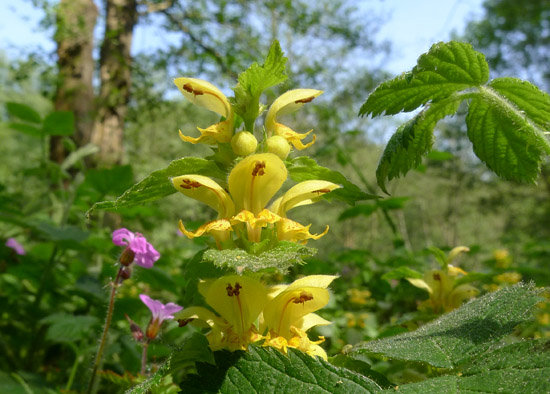
Yellow Archangel, Lamiastrum galeobdolon

Yellow Archangel, Lamiastrum galeobdolon, is a widespread European woodland plant that is fond of heavy soils. It will grow in very shady areas but also likes some sun and can pop up in abundance in areas that have been coppiced. It can also be found on waysides and verges. In the UK the plant is found more in the south and is relatively widespread as far north as Yorkshire, but less so in the west of the country.

Yellow Archangel is in the family Lamiaceae along with dead-nettles and mints. It has attractive yellow, hooded flowers that appear from May to July. When in flower you can clearly see the family resemblance to White Dead-nettle, Lamium album. More generally, Yellow Archangel shares the Lamiaceae family traits of having a stem with square cross-section, and opposite pairs of leaves alternating at 90 degrees to the pair above or below on the stem. The leaves are a similar shape to White Dead-nettle but narrower and more deeply toothed. The flowering stem can grow up to 45cm tall but is often shorter than this.

Yellow Archangel is edible and the plant can be used in the same way as White Dead-nettle, Lamium album. The young leaves and shoots can be eaten raw. Later, when the plant is more mature, and the leaves are tougher, you can steam or lightly cook the leaves and eat as a green. At any stage you can add the leaves to soups as you would the leaves of Stinging Nettle, Urtica dioica.
Best Practice while Foraging
Please read the BSBI’s Code of Conduct for the Conservation and Enjoyment of Wild Plants for guidance on the best practice (and UK laws) relating to foraging for wild plant foods.
Disclaimer
This article is meant only as a guide and is largely a record of my recent forages. It is not a complete treatment of all edible plants that might be available. Nor does it provide a complete treatment of all poisonous plants that may also be present in the habitat where you find the above-mentioned plants. If you want to learn more about plant identification you should invest in some good field guides. The safest way to learn about edible wild plants is for someone who already has the knowledge to show you in person. Any foraging you do on your own is at your own risk.
The most important thing to remember when identifying wild foods is:
IF IN DOUBT, LEAVE IT OUT!
Recommended Books for Further Reading
Related Articles on Paul Kirtley’s Blog
White Dead-nettle, Lamium album
Red Dead-nettle, Lamium purpureum
8 thoughts on “Yellow Archangel, Lamiastrum galeobdolon”
I like the inclusion of the less obvious edibles in your blog, Paul. This one is great! Just looked it up in the Wildflowers of Offaly book. Unfortunately, Yellow Archangel (Neantog mhuire in Gaeilge) is rare here but still going to look out for it! 🙂
Hi Paul, I like your last posts! Keep up the good work!
Hi Paul,
The only Yellow Archangel I’ve come across in my neck of the woods (mid-Cornwall) is the variegated garden-escape variety that seems to be quite invasive in the local woods.
Have you come across this, and is it as edible as the wild-type?
Hi Shaun,
Both varieties are quite prolific where they occur. The variegated garden-escape is edible in the same way as the native variety.
All the best,
Paul
Nice to see this here and good to stumble upon your blog. Do you mean rare in the South East rather than South? It is not so rare in the South West, it was quite common in South Devon. I’ve nibbled on this raw but to be honest the flavour wasn’t so great that it made me rush out and cook it, is it worth it, got any good recipes?
Hi
Does the variegated variety flower every year ?
There is a patch growing on a woodland verge here in my part of Lancashire.
I have only seen it flower though once in four years – a spectacular sight !
Regards
It is a perennial but that doesn’t necessarily mean it flowers every year.
Best,
Paul
Please encourage people to eat the variegated yellow archangel NOT the native species which is rare in some parts. The variegated form is an invasive non native species listed on schedule 9 of the Wildlife & Countryside Act 1981 so they would be doing the wild flora a favour.